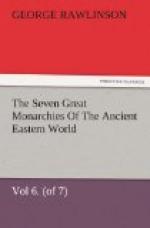In the early times of the empire the Magi were held in high repute, and most of the peculiar tenets and rites of the Magian religion were professed and followed by the Parthians. Elemental worship was practised. Fire was, no doubt, held sacred, and there was an especial reverence for rivers. Dead bodies were not burned, but were exposed to be devoured by birds and beasts of prey, after which the dry bones were collected and placed in tombs. The Magi formed a large portion of the great national council, which elected and, if need were, deposed the kings. But in course of time much laxity was introduced. The Arsacid monarchs of Armenia allowed the Sacred Fire of Ormazd, which ought to have been kept continually burning, to go out; and we can scarcely suppose but that the Parthian Arsacidae shared their negligence. Respect for the element of fire so entirely passed away, that we hear of the later Parthians burning their dead. The Magi fell into disrepute, and, if not expelled from their place in the council, at any rate found themselves despised and deprived of influence. The later Parthian religion can have been little more than a worship of the Sun and Moon, and of the teraphim, or sacred images, which were the most precious possession of each household.
While thus lax and changeful in their own religious practice, the Parthians were, naturally, tolerant of a variety of creeds among their subjects. Fire altars were maintained, and Zoroastrian zeal was allowed to nourish in the dependent kingdom of Persia. In the Greek cities the Olympian gods were permitted to receive the veneration of thousands, while in Babylon, Nearda, and Nisibis the Jews enjoyed the free exercise of their comparatively pure and elevated religion. No restrictions seem to have been placed on proselytism, and Judaism certainly boasted many converts from the heathen in Adiabene, Charax Spasini, and elsewhere. Christianity also penetrated the Parthian provinces to a considerable extent, and in one Parthian country, at any rate, seems to have become the state religion. The kings of Osrhoene are thought to have been Christians from the time of the Antonines, if not from that of our Lord; and a nourishing church was certainly established




